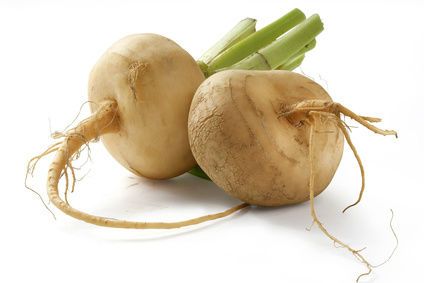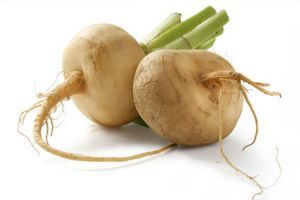
In the U.S., rutabagas are simply called rutabagas, but throughout much of the rest of the world they are known as “swedes.” This root veggie is thought to have originated as a cross between a turnip and a wild cabbage and is a cruciferous vegetable like broccoli and Brussels sprouts.
All cruciferous veggies are high in antioxidants and anti-cancer compounds. The most significant nutrient from the rutabaga is vitamin C, with one cup containing over half of the daily recommended value.
Just some of the rutabaga’s known health benefits include:
Cancer prevention. The rutabaga contains potent phytochemicals that help to eliminate carcinogens, aid the liver in processing harmful toxins, possibly preventing the development of cancerous tumors and slowing free radical damage to our body’s cells. According to the University of Washington Seattle Cancer Care Alliance , eating cruciferous vegetables like rutabagas can help decrease the risk of prostate cancer.
Immunity booster. Because rutabagas are packed with vitamin C, they also help to strengthen the immune system and can even help cure a number of ailments.
Improving digestive health. Rutabagas also contain lots of dietary fiber, essential for maintaining a healthy digestive tract. Consuming fiber helps to decrease the risk of colon cancer, protect against type-2 diabetes and lowers the risk of heart disease.
Weight loss. As these veggies are low-calorie and high fiber, they can be an excellent part of any weight loss plan. The fiber helps to keep you fuller longer, preventing unhealthy snacking and is even thought to help boost the metabolism.
Reducing asthma symptoms. Due to the rutabaga’s abundance of vitamin C, consuming them is also known to help reduce wheezing in asthma patients.
How to shop
When shopping for rutabagas, keep in mind that they look similar to turnips but are larger and have yellower flesh. It’s best to select those that are 3 to 5 inches in diameter; the smaller they are, the sweeter they are. They should feel firm, smooth and heavy and have no cracks or soft spots. Of course, always choose organic to avoid pesticides and other harmful toxins.
How to cook
One of the best ways to use rutabagas is to cook them like you would mashed potatoes. Just boil and strain, add organic grass-fed butter, a little organic cream and fresh thyme.
 Roasted rutabagas are also popular. Peel and cut up about one pound of rutabaga into ½ to ¾ inch pieces. Toss them with organic extra-virgin olive oil, coating generously, and then sprinkle on some sea salt and fresh ground black pepper. Place them onto a baking sheet, arranged evenly and then put them into a 475 F degree oven. Cook for 13 to 15 minutes, or until browned on the bottom and then flip and continue to cook for another 5 to 10 minutes until tender.
Roasted rutabagas are also popular. Peel and cut up about one pound of rutabaga into ½ to ¾ inch pieces. Toss them with organic extra-virgin olive oil, coating generously, and then sprinkle on some sea salt and fresh ground black pepper. Place them onto a baking sheet, arranged evenly and then put them into a 475 F degree oven. Cook for 13 to 15 minutes, or until browned on the bottom and then flip and continue to cook for another 5 to 10 minutes until tender.
-The Alternative Daily

